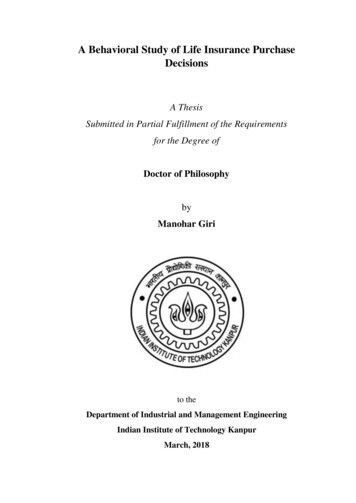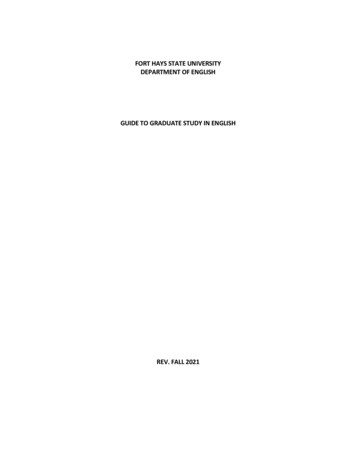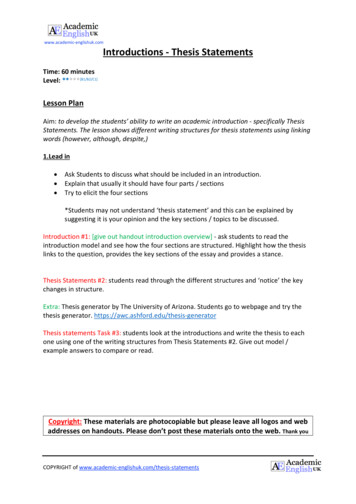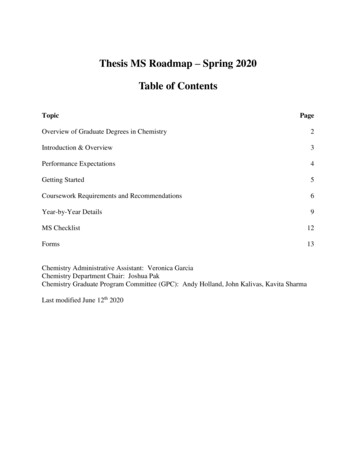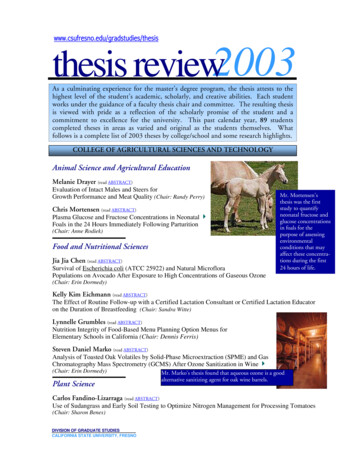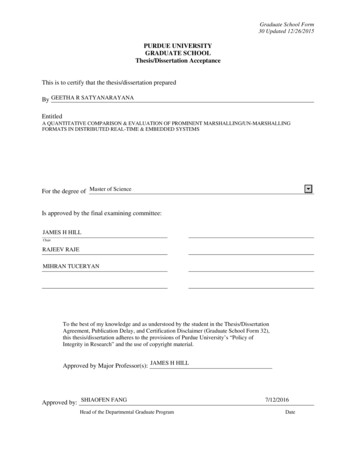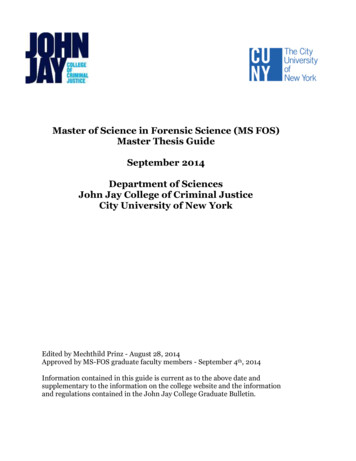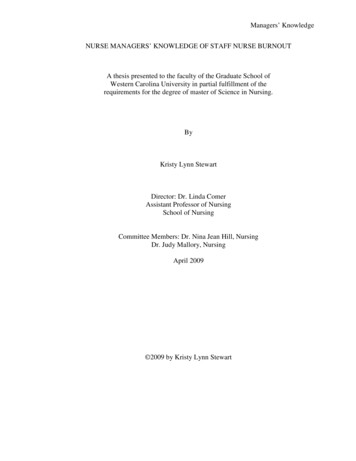
Transcription
Managers’ KnowledgeNURSE MANAGERS’ KNOWLEDGE OF STAFF NURSE BURNOUTA thesis presented to the faculty of the Graduate School ofWestern Carolina University in partial fulfillment of therequirements for the degree of master of Science in Nursing.ByKristy Lynn StewartDirector: Dr. Linda ComerAssistant Professor of NursingSchool of NursingCommittee Members: Dr. Nina Jean Hill, NursingDr. Judy Mallory, NursingApril 2009 2009 by Kristy Lynn Stewart
Managers’ KnowledgeACKNOWLEDGEMENTSI would like to thank my committee members and director for their assistance. Inparticular, I would like to thank Dr. Comer for her continued support and commitment to myeducation. I would also like to thank Dr. Hill for her expert assistance with formatting the survey.I also extend sincere thanks to my family and friends for their continued support andencouragement. In particular, I would like to thank my husband, Mike Stewart, for hisencouragement and understanding throughout this educational process.
Managers’ KnowledgeTABLE OF CONTENTSPageList of Tables . . .5List of Figures .6Abstract . .7Chapter I: Background and Rationale for Study . .8Introduction . .8Problem Statement .12Justification of Study .12Conceptual Framework .13Assumptions .17Research Questions 17Definition of Terms .18Chapter II: Literature Review . . 19What is Burnout?.19Nursing is Stressful 21Stress is Related to Burnout .21Nursing is Related to Burnout .24Cost of Burnout .24Significance of Nursing Burnout .25Causes of Burnout .28Burnout Prevention Measures for the Nurse . .30Burnout Treatment Measures for the Nurse .34Burnout Prevention Measures for the Nurse Manager to Implement 34Burnout Treatment Measures for the Nurse Manager to Implement . 40Gaps in Research .41Chapter III: Methodology . .43Research Design .43Setting . .43Population and Sample .44Protection of Human Subjects .45Instrument .45Data Collection .47Data Analysis .47Limitations .48Chapter IV: Results . .50Sample Characteristics .50Major Findings .50Chapter V: Discussion . 67Implications for Future Research . .70Implications for Nursing Education .70Conclusion .71References . 73
Managers’ KnowledgeAppendices . .84Appendix A: Staff Nurse Burnout: A Survey for Nurse Managers . 84Appendix B: Reminder Letter . .87
Managers’ KnowledgeLIST OF TABLESTable1.2.3.4.5.6.7.PageDemographic Characteristics . .60Total Selection of Survey Options Related to Demographics. .61Correlation of Knowledge at Different Ages . . . 54Correlation of Knowledge at Different Years as Manager . .55Correlation of Knowledge at Different Educational Degrees . .56Survey Options Selected. . . 62Statistical Measures . .57
Managers’ KnowledgeLIST OF FIGURESFigurePage1.The Effects of Nurse Manager Knowledge on Nursing Burnout. . .162.The Spiraling Effect of Nursing Stress and Burnout . .23
Managers’ KnowledgeABSTRACTNURSE MANAGER KNOWLEDGE OF STAFF NURSE BURNOUTKristy Stewart, RN, MS(N) candidateWestern Carolina University (April 2009)Director: Dr. Linda ComerNursing burnout affects the nurse’s home and work life and can lead to serious physicaland emotional symptoms as well as patient dissatisfaction and increased nursing turnover.With a shortage of nurses expected to increase to 30% across the state of North Carolinaby the year 2020, it is imperative we prevent further loss to burnout. An educationalneeds assessment was conducted via a mailed survey to determine the current knowledgeof nurse managers employed in hospitals in North Carolina regarding causes of burnoutand methods of burnout prevention and reversal for staff nurses. The responses of 214nurse managers allowed the identification of their level of knowledge about staff nurseburnout. Through comparison with published knowledge about the subject, theeducational needs of the managers are apparent. The findings of this research can informthe provision of appropriate education for nurse managers, leading to reduced burnout instaff nurses, a reduction in the nursing shortage, and improved quality of patient care.The burnout information least known by nurse managers is evidence-based knowledgeand theoretical knowledge is better known. The findings reveal a positive correlationbetween nurse manager’s total knowledge and age, years as nurse manager, and level ofeducation completed. The greatest knowledge need is in the area of environmental causesof staff nurse burnout.
Managers’ Knowledge8CHAPTER I: BACKGROUND AND RATIONALE FOR STUDYIntroductionNursing is a profession which has existed for centuries. In ancient civilizations,nursing-type care was given by women and men, and, in some cases, slaves whoprovided physical and comfort care. During the eighteenth and nineteenth centuries,nursing was provided by religious organizations or by women who were either prisonersor prostitutes. During the nineteenth century, nursing changed due to the development ofhospital training schools for nurses and Florence Nightingale’s influence. The role of thenurse evolved from housekeepers to trained caregivers when schools of nursing werefounded. From the late 1800s to the end of World War I, nursing practice was beginningto transition to the hospital setting as education also took place in the hospital. This wasfollowed in the early 1900’s by the development of university nursing schools that wereindependent of hospitals to provide better training. In the 1940’s nurses began to developa need for specialty education as patients were separated within hospitals according totheir disease. Advanced education was developed to prepare nurses in other areas as well,such as administration and teaching. During this time, nursing research began andincreased through federal funding to study nursing education in the 1950’s, theknowledge of nursing practice in the 1960’s, and practice related issues in the 1970’s.(Kozier, Erb, Blais, & Wilkinson, 1998). Between 1950 and 2000, educational programrequirements were being developed and enforced. Private insurance, Medicare andMedicaid, and the development of technology led to an increased demand for nurses
Managers’ Knowledge9(Keating, 2006). It has not been until recently, in the 1970’s, that nursing was finallyconsidered a profession (Tomey & Alligood, 2006). During the 1980’s to 2000 thenumber of advanced education programs grew including master’s level education forclinical nurse specialists, nurse practitioners, and doctoral programs focusing on research.Yet, the supply of nurses could not keep up with the demand (Keating, 2006).Nurses now work in many different areas including outpatient settings, nursinghomes, and community health agencies in addition to hospitals (Kozier, et al., 1998).Today, technology with the advanced ways to diagnose, treat, and cure diseases hasprolonged life expectancy leading to an increasing number of elderly patients who havegreater healthcare and nursing care needs (Shi & Singh, 2005). Nursing has been throughmany changes; yet the profession has continued to be a necessary part of healthcare andnurses have become the largest segment of healthcare staff (Milliken, Clements, &Tillman, 2007).Since nursing care affects both nurses and patients, the current nursing shortage issuch an important concern for everyone today. North Carolina (NC) is already in a stateof registered nurse shortage. The average NC hospital vacancy of registered nurses is7.7%. It has been suggested by the NC Center for Nursing that a vacancy rate of over 8%leads to further staff turnover (Lacey & McNoldy, 2007c). The nursing shortage isexpected to increase over the next several years. By the year 2020, North Carolina isexpected to have only 70% of the nurses needed (Lacey & Nooney, 2006). There aremany factors which contribute to this shortage.Poor nurse staffing patterns, such as short-staffing and unbalanced acuity, canhave negative consequences for the entire healthcare field. Two results of an insufficient
Managers’ Knowledge10number of nurses providing care to an increasing patient population are decreased patientand staff satisfaction and decreased quality of patient care (Pendry, 2007). Retirement isanother cause of turnover that has contributed to the nursing shortage (Lacey & Nooney,2006). The loss of a nurse from the job further decreases the staff available leading tomore patients per nurse and, thus greater stress (Garrosa, Moreno-Jiménez, Liang, &González, 2008). This process, if left uninterrupted, will worsen the nursing shortage.Burnout is another cause of loss of nurses which also can lead to decreased patientand staff satisfaction and decreased quality of patient care (Milliken, et al., 2007).Erickson and Grove (2007) found that 43.6% of nurses under 30 years old and 37.5% ofnurses over 30 years old had experienced emotional burnout. Burnout is defined asfeeling of complete emotional and physical exhaustion resulting from prolonged stress atwork that has negative effects on the individual nurse, the patient, the organization, thenurse’s family and personal life (Altun, 2002; American Institute of Stress; BilleterKoponen & Fredén, 2005; Edward & Hercelinsky, 2007; Espeland, 2006; Iacovides,Fountoulakis, Moysidou & Ierodiakonou, 1997; Maslach, 2001; Maslach & Leiter, 1999;Schaufeli & Taris, 2005; Schneider, 2007; Wu, Ahu, Wang, Wang, & Lan, 2007).Burnout is considered to have a negative effect on job and life satisfaction (Demerouti,Bakker, Nachreiner, & Schaufeli, 2000). Burnout can lead to the nurse leaving not onlythe current job (Milliken, et al.), but also the nursing workforce. Shortage of staff can, inturn, lead to increasing likelihood of burnout. Aiken, Clarke, Sloane, Sochalski, andSilber (2002) found that even the addition of one patient per nurse measurably increasedburnout in staff. Methods of burnout prevention and treatment must be in place to lessenthe suffering and loss of nursing staff.
Managers’ Knowledge11The entire organization must be involved to put burnout prevention and burnouttreatment or reversal measures into place. Nurse managers are in an excellent positionbetween the staff nurse and upper administration which allows them to serve as anadvocate for nursing staff. Managers, unlike administrators, have direct daily contact withnursing staff. Also the managers, unlike nursing staff, have direct contact withadministrators. Nurse managers can convey major staff concerns and staffing issuesdirectly with administrators who have the ability to make drastic changes within theenvironment or organization. Nurse managers are a valuable liaison between uppermanagement and staff nurses and have the opportunity to be an advocate for staff nurses.There is a lot of available information about staff nurse burnout. There aresuggestions available for encouraging work excitement (Sadovich, 2005) or foraddressing moral distress (Pendry, 2007). There are many recommendations for basicstaff satisfaction measures such as flexible scheduling, increasing participation indecision-making, and reward systems (Demerouti, et al., 2000; Rivers, Tsai, & Munchus,2005; Lussier, 2006; Cohen, 2006; Lacey & Shaver, 2002b). Other guidance can befound by considering the large array of research suggesting causes of burnout. The causescan be examined under the assumption that their prevention would limit burnout.However, there is a lack of knowledge of what information the nurse manager does anddoes not know. Considering the plethora of burnout information available it is vital tounderstand exactly what the manager already knows and what guidance and assistancethe nurse manager needs to help staff nurses prevent burnout. Limiting the information toonly that which is needed and helping to focus on the knowledge gaps could allow for thedesign of specific educational interventions for the nurse manager.
Managers’ Knowledge12Problem StatementThe purpose of this study is to determine the educational needs of nurse managersrelated to causes of burnout, methods of burnout prevention, and burnout treatment orreversal for staff nurses.Justification of StudyThere is a lack of evidence describing nurse managers’ knowledge levelsregarding burnout prevention and treatment. This lack of data leaves the nurse educatorguessing what the manager needs to know and potentially repeating known suggestionswhile omitting new information. Knowing the educational needs of the nurse managerscan guide further research, as well as guide nurse educators in the provision of continuingeducation for the nurse manager. One of the main reasons for choosing to attendcontinuing education classes for the adult learner is to learn what is needed to solveidentified problems. Educational needs are determined by identifying knowledge gapsused to guide the planning and implementation of education (Bastable, 2003). Thus, byidentifying the information that is needed, the educational offering will be more readilyaccepted. The loss of nurses to burnout can be decreased by adding more burnoutprevention and treatment measures or aides to the nurse manager’s skill set. Withdecreased stress, less staff will be lost to burnout. Sufficient staffing helps to decrease theloss of staff and increase job satisfaction ( Aiken, Clarke, Sloane, Sochalski, & Silber,2002) and gives nurses the ability to provide better patient care (American Association of
Managers’ Knowledge13Critical-Care Nurses [AACN], 2005; Denney, 2003; Joint Commission on Accreditationof Healthcare Organizations [JCAHO], 2002; Pendry, 2007). Thus the final outcome isthat the nursing shortage will be reduced and the quality of patient care will be improved.There is the potential to change the course of healthcare by giving educators theknowledge to design courses for nurse managers that would focus specifically on theiridentified learning needs. This will give nurse managers the tools to prevent and helpreverse burnout in staff nurses and, therefore, lead to a reduction in the loss of nurses dueto burnout, and decrease the severity of the nursing shortage.Conceptual FrameworkThere are a variety of studies that identify some of the causes of burnout innurses. Results of the studies vary based on the specific sample studied and the aim of theproject; and, they encompass a wide range of possibilities for improvement. The ideas forprevention and treatment of burnout range from simple to incorporate into daily life ordaily work life to more complex strategies. For example, recognizing staff foraccomplishments is an easy way to increase satisfaction and help prevent progressiontoward burnout (Denney, 2003; Faron & Poeltler, 2007; Bally, 2007; McGrath, Reid, &Boore, 2003). Others may require more time and work to implement such as Garrosa,Moreno-Jiménez, Liang, & González’s (2008) findings that increasing control andcommitment will help prevent burnout. Despite the wide array of options forimplementing burnout prevention and treatment measures, the number of nurses thatreport experiencing burnout remains high. Hillhouse and Adler (1997) found 69% of the
Managers’ Knowledge14nurses studied were experiencing burnout. If we know many of the causes of burnout andhow detrimental its effect can be on the individual, patient, and organization, why doesburnout remain a problem?One reason burnout remains a factor in nursing may be due to the lack ofimplementation of prevention and treatment measures. The possible causes and potentialprevention and treatment measures for burnout are well disseminated. Since burnoutcontinues to be a significant problem, it can be assumed that these measures are not beingput into practice. Since the significance of burnout is apparent, it may be a lack ofknowledge of burnout on the part of the nurse manager that is contributing to the burnoutcycle. The nurse manager holds an important role in maintaining staff satisfaction(AACN, 2005). The nurse manager is the administrator most closely in tune with the staffnurses. This position between upper administration and staff nurses gives the nursemanager the most critical role in breaking the burnout cycle. The manager spends enoughtime with the staff nurses to maintain an assessment of their stress health and is also apart of administration, lending the opportunity to encourage that positive changes bemade within the system or at least on his or her unit.The reason burnout remains such an issue in nursing may be due to the lack of useof the available knowledge. Assessing nurse managers’ current knowledge of burnout,burnout prevention and treatment measures and comparing the results to the availableguidelines related to burnout will demonstrate the knowledge and knowledge gaps of thenurse manager. Perhaps it is this missing information that will help make a difference inthe number of staff nurses experiencing burnout.
Managers’ Knowledge15As the nurse is affected by the causes of burnout, the nurse manager reactsaccording to his or her knowledge of the available burnout facts. When the nursemanager has little knowledge of burnout, the reaction will be little prevention and littletreatment or reversal measures put into practice. The result will be continued loss ofnurses to burnout and repeat of the cycle as in Figure 1. A. When the nurse manager has amid level of knowledge of burnout, the reaction to the effect of causes will be anincreased implementation of preventive and treatment measures. Treatment will be themain focus as staff nurses will be experiencing some symptoms of burnout. The manageris not aware of all of the available knowledge so some prevention measures are unknownallowing for the causes to persist leading to a build-up of stressors that can cause burnoutas illustrated in Figure 1. B. As the knowledge of the nurse manager approaches allavailable knowledge of burnout, the reaction to the causes of burnout affecting the nursewill be to increase prevention and treatment measures. Here, prevention measures will bethe focus as the manager has the all the tools needed. Symptoms of staff can be reversedand prevention measures can be implemented. With all of the facts known, all of thecauses will be addressed by the manager’s knowledge leading to the maintenance ofprevention as the main method for continuing staff satisfaction and retention as illustratedin Figure 1. C.
Managers’ Knowledge16A.FactsPreventionCauses ofburnoutKnow.ManynurseslostTreatmentThis ineffective process repeats.B.Causes reatmentLess lossof nursesThe process repeats.C.FactsPreventionCauses ofburnoutsatisfactionKnow.TreatmentNursesstayThe process is modified.Figure 1. The effects of nurse manager knowledge on nursing burnout. Note: “Know.” isnurse manager’s knowledge of the facts about burnout causes, prevention, and treatment.
Managers’ Knowledge17AssumptionsThis research takes place under the following assumptions:1. Nurses in North Carolina are experiencing burnout similarly to other nurses who wereassessed in previous research.2. Nurse managers will complete the survey accurately in order to improve theknowledge of burnout.3. One cause of burnout is that nurse managers lack knowledge of burnout causes andprevention measures.4. If nurse managers were knowledgeable about burnout, they would put the knowledgeinto practice.5. Nurse managers know what burnout is and that it is not the same as stress.6. Those nurses registered with the North Carolina Board of Nursing who selected thetitle of head nurse or assistant are nurse managers.Research Questions1. Do nurse managers know all of the potential causes of burnout?2. Do nurse managers know all of the potential preventative measures of burnout?3. Do nurse managers know all of the potential treatment measures of burnout?4. What knowledge gaps do nurse managers exhibit about burnout?5. Does the number of years working as a nurse manager affect knowledge?6. Does age affect nurse manager knowledge?7. Does level of education affect nurse manager knowledge?
Managers’ Knowledge18Definition of TermsNurse manager: registered nurse in charge of a hospital nursing unit in the positionbetween staff nursing and hospital administration and listed with the North CarolinaBoard of Nursing as head nurse or assistantNurse managers’ knowledge: the information gathered from the survey.Staff nurse: registered nurse working in patient care on a hospital nursing unit.Burnout: feeling of complete emotional and physical exhaustion resulting from prolongedstress at work that has negative effects on the individual nurse, the patient, theorganization, and the nurse’s family and personal life (Altun, 2002; American Institute ofStress; Billeter-Koponen & Fredén, 2005; Edward & Hercelinsky, 2007; Espeland, 2006;Iacovides, et al., 1997; Maslach, 2001; Maslach & Leiter, 1999; Schaufeli & Taris, 2005;Schneider, 2007; Wu, et al., 2007).Burnout cause: prolonged stress at work resulting from a variety of stressors that eitherindividually or together lead the nurse to experience burnout.Burnout prevention measures: actions which inhibit the onset of burnout in the staffnurse. Those actions reported as keeping burnout from occurring.Burnout treatment or reversal measures: actions which dispel burnout in the staff nurse.Those actions reported as helping to reverse burnout in the nurse.
Managers’ Knowledge19CHAPTER II: LITERATURE REVIEWWhat is Burnout?We have all heard of burnout. The term can be used to refer to different parts ofour lives, but usually is in reference to one’s work life. Burnout may be seen bycoworkers as the effects of personal conflict or the lack of enjoyment of one’s job(Maxfield, Grenny, McMillan, Patterson & Switzler, 2005). Sadovich (2005) has foundthat work excitement effects burnout. This assessment may be correct; yet, true burnoutgoes much deeper. Stress in the workplace does affect one’s personal stress levels just asstress in one’s personal life can affect workplace stress (Hurley, 2007). However, it takesfeeling unrelenting stress over a long period of time to finally lead to the result of burnout(Altun, 2002; American Institute of Stress, n.d.; Billeter-Koponen & Fredén, 2005;Demerouti, Bakker, Nachreiner, & Schaufeli, 2000; Iacovides, Fountoulakis, Moysidou,& Ierodiakonou, 1997; Khowaja, Merchant, & Hirani, 2004; Schneider, 2007; Wu, Zhu,Wang, Wang, & Lan, 2007).Burnout is frequently related to emotional feelings. For example, maincomponents of the burnout syndrome include exhaustion and depersonalization(Iacovides, et al., 1997; Sadovich, 2005; Schaufeli, Bakker, Hoogduin, Schaap, &Kladler, 2001; Schaufeli & Taris, 2005; Taormina & Law, 2000). Another majorcomponent of burnout is feelings related to personal achievements (Iacovides, et al.;Taormina & Law; Wu, et al., 2007). Pines (2004) describes burnout as being related toattachment styles. She finds that the more secure, rather than anxious or avoidant, the
Managers’ Knowledge20adult’s attachment style, the more likely the participant would notice causes of burnoutand be less likely to experience burnout. Maslach (2001) further defines burnout as a typeof mental illness.Other researchers agree that burnout is related to mental health in addition to itsother life effects. There are physical, social, and organizational or environmental as wellas mental effects from and on burnout (Wu, et al., 2007). Burnout causes feelings ofdepression, fatigue, loss of sense of humor, dissatisfaction, and ability to be alert andlearn (Altun, 2002; American Institute of Stress, n.d.; Billeter-Koponen & Fredén, 2005).The burned out employee feels as though there is too much work to do and feelsunappreciated (Maslach & Leiter, 1999).Burnout results in poor work performance and severe mental and physicalsymptoms such as mental and physical exhaustion, feelings of hopelessness, poor healthin general, boredom, and low self-esteem (Altun, 2002). In addition, other physicalsymptoms result such as migraines, eating problems, muscle weakness or pain, loss ofsexual desire, high blood pressure, and high blood sugar (Schneider, 2007; BilleterKoponen & Fredén, 2005). Schneider goes on to suggest possible severe consequences ofburnout including coronary disease, heart attack, asthma, hostility, suicidal feelings, anduncontrollable crying. All of these symptoms affect each part of one’s life, work andpersonal. They have the potential to change life such that it may not return to the way itwas before the burnout experience. As humans who experience stress we are all subjectto these consequences.
Managers’ Knowledge21Nursing is StressfulNursing is a profession that is particularly vulnerable to stress (Hillhouse &Adler, 1997; Augusto Landa, Lόpez-Zafra, Martos, & Aguilar-Luzόn, 2006; McGrath,Reid, & Boore, 2003; Milliken, Clements, & Tillman, 2007). Augusto Landa, et al.explain that nurses’ stress results from the hospital environment itself. The nature ofnursing and patient care are identified as stressful by Milliken, et al. Specifically, theemotional work required while working with patients is stressful to the nurse who mustbe emotionally available and participatory while maintaining control over emotions(Erickson & Grove, 2007). In reflecting on her own experience, Beech (2007) explainsthat the stress of nursing can be felt at home as well. She reflects on often being askedhealth-related questions and to provide nursing care even while off duty and trying torejuvenate. Nursing is a stressful career and that stress definitely spills over from worklife into home life.Stress is Related to BurnoutThis frequent stress along with the lack of effectively dealing with stress can leadto burnout (Altun, 2002; American Institute of Stress, n.d.; Billeter-Koponen & Fredén,2005; Demerouti, et al., 2000; Iacovides, et al., 1997; Khowaja, et al., 2004; Schneider,2007; Wu, et al., 2007). Specifically, Garrosa, Moreno-Jiménez, Liang, and González(2008) found that an increase in nursing job stressors can increase the tendency towardburnout. Increasing burnout led to greater job stress, less satisfaction, and poorer
Managers’ Knowledge22performance according to Sadovich, (2005). Nursing is stressful and this stress can leadto burnout. Burnout starts with one nurse feeling stressed, and without properinterventions the stress builds and can lead to burnout. The burnout of one nurse, and thusthe loss of one nurse from the team, leads to more work for the remaining nurses. Thisextra workload can cause stress on the remaining nurses which may build and lead toanother nurse’s burnout. This spiraling effect of burnout is illustrated in Figure 1beginning in the center of the figure with a single nurse experiencing stress. In thismanner, stress and burnout can feed upon one another and have catastrophic effects onthe nursing workforce.
Managers’ KnowledgeBurnoutTwo burned out nurses, andthe process continues. . .StressBurnoutStressOne stressed nurseStressStressBurnoutBurnoutFigure 2. The spiraling effect of nursing stress and burnout. The process startswith one stressed nurse and can lead to many being burned out.23
Managers’ Knowledge24Nursing is Related to BurnoutThe nursing profession has been identified to be at a great risk for burnout (Altun,2002; Demerouti, et al., 2000; Edward & Hercelinskyj, 2007; Garrosa, et al., 2008; Đlhan,Durukan, Taner, Maral, & Bumin, 2007; Milliken, et al., 2007; Wu, et al., 2007).Demerouti, et al. has identified that a great cause of stress and emotional taxing isexperienced when caring for people and dealing with patient’s concerns and feelings.This describes a specific stress in nursing that leads to the general link to increased riskfor burnout. Aiken, Clarke, Sloane, Sochalski, & Silber, (2002) found that over 40% ofthe nurses studied were experiencing burnout. Burnout is obviously a well identifiedproblem considering all of the research that is available.Cost of BurnoutPart of the significance of burnout on nurses is reflected in the great cost we allpay as patients and as nurses. First, patients pay in terms of decreased satisfaction withcare and poorer outcomes from nursing care (AACN, 2005; Denney, 2003; JCAHO,2002; Pendry, 2007). Additionally, the organizations pay in terms of increased cost sinceburnout in general is financially costly (Flinkman, Laine, Kilpi, Hasselhorn, & Salanterä,2008; Hillhouse & Adler, 1997; Maslach & Leiter, 1999). Recruitment of new employees(Lacey & McNoldy, 2007b) and training new nurses (Rivers, et al., 2005) are expensivetasks for the organization. Also, when nurses are burned out they do poor work which can
Managers’ Knowledge25also cause increased costs to the facility (Maslach & Leiter, 1999). Poor patient care(American Institute of Stress
Western Carolina University in partial fulfillment of the requirements for the degree of master of Science in Nursing. By Kristy Lynn Stewart Director: Dr. Linda Comer Assistant Professor of Nursing School of Nursing Committee Members: Dr. Nina Jean Hill, Nursing Dr. Judy Mallory, Nursing April 2009 2009 by Kristy Lynn Stewart



